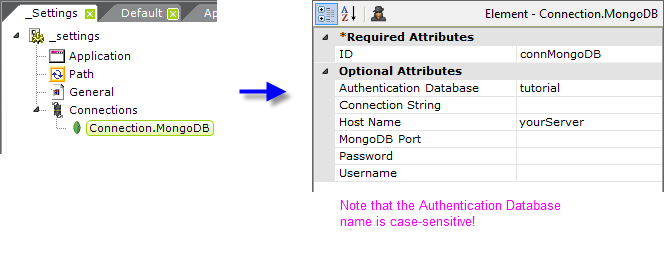DataLayer.MongoDB
MongoDB is a cross-platform, document-oriented database system, classified as a "NoSQL" database. Rather than using a traditional table-based, relational DB structure, it uses a collection of JSON-like documents with variable schemas. Logi Info and Report include the DataLayer.MongoDB element to retrieve data from this system. This topic discusses this datalayer.
- Attributes
- Work with DataLayer.MongoDB
![]() General information about MongoDB can be found at the official website.
General information about MongoDB can be found at the official website.![]() This element was deprecated in v11.2.040 and replaced by three new MongoDB-specific datalayers.
This element was deprecated in v11.2.040 and replaced by three new MongoDB-specific datalayers.
Attributes
The DataLayer.MongoDB element has the following attributes:
| Attribute | Description |
|---|---|
| Collection | (Required) Specifies the name of the document collection to open. |
Connection ID | (Required) Specifies the ID of a Connection.MongoDB element in the application's _Settings definition. This element is discussed in more detail in the next section. |
| ID | A unique element ID. |
| Maximum Rows | Specifies a the maximum number of data rows to retrieve. If left blank, then all records that satisfy the request will be retrieved. |
| Preserve Hierarchy | Specifies if data is to remain in its original, hierarchical form. If set to False, the data is processed to create traditional rows and columns. Default: True |
XPath | Specifies a standard XPath string that will be used to select a set of matching nodes. All of the matching nodes are then used to generate the resulting datalayer. |
Work with DataLayer.MongoDB
In many respects, DataLayer.MongoDB functions exactly as other datalayer elements do and its data can be filtered and conditioned using appropriate child elements. Like other datalayers, it works with a specific Connection element, Connection.MongoDB, to connect to the datasource.

As shown above, the Connection.MongoDB element is added to the _Settings definition, beneath the Connections element. Attributes are set appropriately for the MongoDB datasource.

Next, in the report definition, a DataLayer.MongoDB element is added as a child element of a data table or another data container element. Its attributes are set so that it accesses the desired MongoDB connection and data collection.
The datalayer reads and caches the data from the datasource. You can add standard child elements beneath the datalayer to affect its contents, including:
- Filtering: Sort, group, or restrict the data
- Extending: Add virtual columns to the datalayer that contain aggregated, calculated, or totaled data values
- Securing: Limit access to the data using Logi security
- Linking: Make the results reusable elsewhere in your report definitions
The use of many of these elements is described in separate DevNet documents.
Data read into the datalayer is cached in XML format in memory and/or on the web server's file system. The latter is discussed in The Logi Server Engine and may be of interest to developers working with extremely large datasets or large numbers of concurrent users.
The data read with the datalayer is available using @Datatokens, in the format @Data.ColumnName~. The spelling of the column name is case-sensitive. The data is only available within the scope of the parent element of the datalayer, not throughout the entire report definition. The DataLayer.Linked element can be used to make the data reusable in another datalayer outside this scope.
The data retrieved into the datalayer can be viewed by turning on the
Debugging Link in your _Settings definition (General element) and using
the resulting link at the bottom of your report page to view the Application
Trace page. A link on the Debug page will display the retrieved data.
Special Child Elements
As a "NoSQL database", MongoDB responds to its own command language rather than traditional SQL commands. DataLayer.MongoDB is provided with a special set of child elements that allow MongoDB commands to be issued, as described below:
| Element | Description |
|---|---|
| MapReduce | Specifies a JavaScript map-reduce operation, used to condense large volumes of data into useful aggregated results. See examples of the code for each attribute value below. |
| NoSQL Column | Specifies the data columns that are to be returned, in a case-sensitive, comma-separated list. |
| NoSQL Compare Filter | Limits returned data to documents that meet the comparison criteria. |
| NoSQL Filter | Limits returned data to documents that cause the expression to evaluate to True. Its NoSQL Expression attribute uses a JSON filtering statement, such as: { $and: |
| NoSQL Group | Groups the data based on the values found in one or more keys. May be used with the NoSQL Aggregate element to aggregate grouped values, using Average, Count, Max, Min, or Sum functions. |
| NoSQL Sort | Specifies the order of the data. |
MapReduce Attribute Code Examples
The following attribute value examples give you an idea of how JavaScript is formatted and used in the MapReduce element.
Attribute: Map
function()
{
var item = this;
emit(item.state, {count: 1, Population: item.pop} );
}
Attribute: Reduce
function(key, values)
{
var result = {count: 0, totalPopulation: 0};
values.forEach(
function(value)
{
if (value.Population != null) { result.totalPopulation += value.Population; }
result.count += value.count;
}
);
return result;
}
Attribute: Finalize
function(key, value){
value.averagePopulation = value.totalPopulation / value.count;
return value;
}